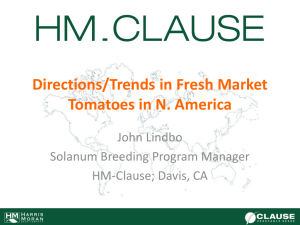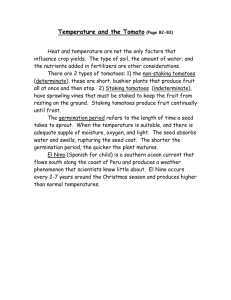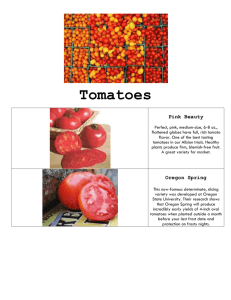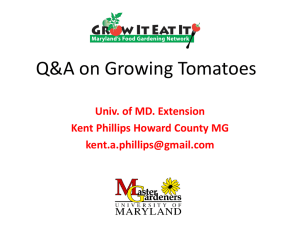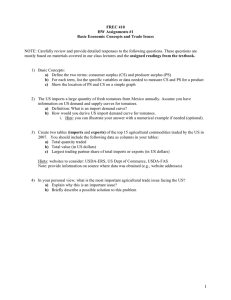Georgia Home Grown Tomatoes
advertisement
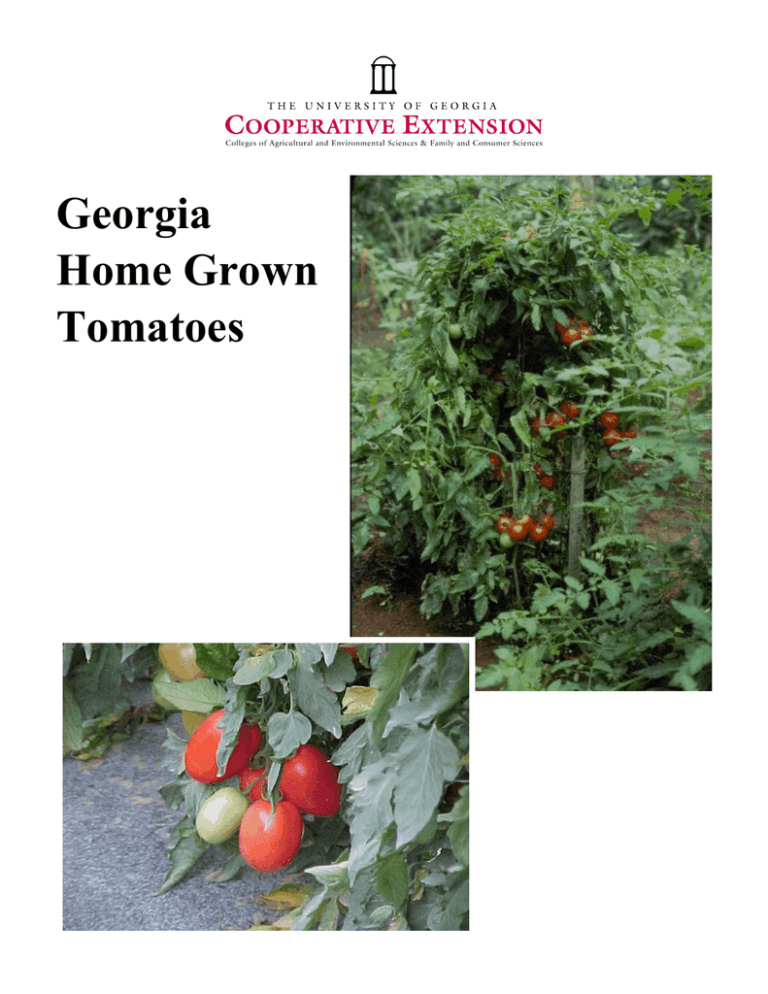
Georgia Home Grown Tomatoes Contents Growing Tomatoes . . . . . . . . . . . . . . . . . . . . . . . . . . . . . . . . . . . . . 3 Getting Started . . . . . . . . . . . . . . . . . . . . . . . . . . . . . . . . . . 3 Soil Requirements .. . . . . . . . . . . . . . . . . . . . . . . . . . . . . . . 3 Planting . . . . . . . . . . . . . . . . . . . . . . . . . . . . . . . . . . . . . . . . 3 Mulching . . . . . . . . . . . . . . . . . . . . . . . . . . . . . . . . . . . . . . . 4 Fertilizing . . . . . . . . . . . . . . . . . . . . . . . . . . . . . . . . . . . . . . 4 Watering . . . . . . . . . . . . . . . . . . . . . . . . . . . . . . . . . . . . . . . 4 Harvesting and Handling . . . . . . . . . . . . . . . . . . . . . . . . . . 4 Tomato Variety Selection . . . . . . . . . . . . . . . . . . . . . . . . . . 4 Determinate vs. Indeterminate . . . . . . . . . . . . . . . . . . . . . . 4 Resistance . . . . . . . . . . . . . . . . . . . . . . . . . . . . . . . . . . . . . . 5 Suggested Tomato Varieties . . . . . . . . . . . . . . . . . . . . . . . . . . . . . . 5 Problems and Pests . . . . . . . . . . . . . . . . . . . . . . . . . . . . . . . . . . . . . 6 Georgia Home Grown Tomatoes Robert R. Westerfield Extension Horticulturist It would be hard to imagine any home garden that did not have at least a few tomato plants. Tomatoes are considered by many to be the most prized vegetable in the garden. There is also plenty of discussion among fellow gardeners as to the best varieties and method of growing each type. This publication will discuss the basics of growing tomatoes successfully, as well as avoiding common problems encountered by the home gardener. six to eight hours of sunlight. Choose a sunny location that receives at least eight hours of sunlight each day. Soil Requirements Tomatoes prefer soil that is well-drained and amended heavily with organic matter. Rotted manures, compost, rotted sawdust or other humus can be tilled into the garden site as soon as the soils can be worked in the spring. Tomatoes require a soil with a pH in the range of 6.2 to 6.8. The pH is the general measurement of acidity in the soil. Soil testing through your local county extension office is the best way to determine the pH. If the pH of the soil is too low, add dolomitic limestone according to the soil recommendations. In the absence of a soil test, apply lime at the rate of 5 pounds per 100 square feet of area. Add lime several months before planting to allow time for it to react with the soil. Till or spade the lime into the soil. Dolomitic limestone also provides calcium and magnesium, which are important elements for the growth and health of the plants. If the pH test comes back normal, but the calcium level is low, apply gypsum at the rate of 1 pound per 100 square feet. Growing Tomatoes Getting Started Tomato plants can be started indoors from seed four to seven weeks before they are to be planted. Transplants can also be purchased from a garden center, ready to plant immediately. If starting your own plants from seed, use a light soil mix and give the plants plenty of light. You may need to use supplemental light if a south-facing sunny window is not available for growing. About a week before transplanting, harden-off indoor grown plants by gradually exposing them to an increasing number of hours of light each day. Tomato plants can be set out in the garden in midMarch to early May after any danger of frost has passed. Some southern areas of Georgia can also produce a second crop of tomatoes when planted in late July. Tomatoes are warm-season plants that grow best at temperatures of 70 degrees to 80 degrees F and require Planting Select only healthy transplants for planting in the garden. Tomatoes can develop roots all along their stems so plant them deeply to encourage a strong root system. Set the transplants down to the first set of true 3 leaves near the soil surface. If transplants are in peat pots, it is not necessary to remove the container, but be sure to plant them deep enough so the pot is not exposed to the soil surface, causing the root ball to dry out. Firm the soil around the plants to force out any air pockets. Give tomatoes a light amount of fertilizer at planting time. This can be accomplished by using a starter solution of fertilizer. Pour about 1 pint of starter solution (2 tablespoons of 5-10-10 or 5-10-5 fertilizer dissolved in 1 gallon of water) around each plant. If plants are to be staked or trellised, space them 24 inches apart in rows 4 to 6 feet apart. Although it requires more work initially, staking makes caring for tomatoes easier and keeps the plant’s leaves from contacting the ground and possibly introducing disease. This in turn produces higher quality fruit. Staking can be done using commercially available cages or by using 6-foot tall, 1-inch square wooden stakes. Drive wooden stakes into the ground about 1 foot deep and 4 to 6 inches from the transplants. Heavy twine or strips of cloth can be used to tie the plants to the stake about every 10 inches vertically as the plants grow. Tomatoes can also be supported by training them to trellises or using a weaving system of cord and stakes. of a soil test, incorporate 1.5 pounds of 10-10-10 fertilizer for 100 square feet of bed prior to planting. Use a complete fertilizer that contains minor nutrients. After the first tomatoes form on the vine and are about the size of a quarter, side-dress them with 10-10-10 at the rate of 1 pound per 100 square feet of bed. Repeat every three to four weeks until harvest is completed. If a liquid soluble fertilizer solution is used, be careful not to apply too much or too frequently as this can lead to excess nitrogen. This is a common problem causing vigorous vegetative shoot growth but few blooms or fruit. Mulching For best quality, harvest tomatoes when they are fully ripened on the vine. If harvested before they are ripe, but after they reach the mature green stage, tomatoes can be allowed to ripen in the home. Place unripe mature green or pink fruit in a room with a temperature of around 70 degrees F. Fruit should be well-ventilated and not jammed together. Fully ripened fruit may be placed in the refrigerator to prolong keeping, but never put unripened tomatoes in the refrigerator. Tomatoes can last several weeks under refrigeration. Watering Tomatoes need about 1 to 2 inches of water per week depending on the type of soil they are growing in. If rainfall does not provide this quantity, water plants thoroughly once or twice per week. One or two heavy soakings are better than many light sprinklings. Consider using drip irrigation or soaker hoses around your plants. These methods will help conserve moisture and avoid getting the foliage wet which can cause disease. Hoses can be laid near each plant above the soil but under the mulch layer. Harvesting and Handling Tomatoes will benefit from mulch placed around their stems. Mulching should be done soon after transplanting. A material such as weed-free straw, chopped leaves or compost can make an excellent mulch and will help conserve moisture and reduce weed growth. Apply mulch to a depth of 2 to 3 inches. Newspaper can also be used as an effective mulch. Lay the newspaper about three sheets thick around plants to act as a weed barrier and to conserve moisture. Then place an organic mulch on top of the paper. Synthetic weed barrier rolls are also available and can be very effective in reducing weed problems and conserving moisture. They work best when laid down over beds prior to planting transplants. Small slits can then be made in the material to allow for planting of the transplants. Soil or small stakes may be needed on the edge of the material to secure it during windy conditions. Tomato Variety Selection When it comes to tomato varieties, the sky is the limit. They come in a large assortment of shapes, sizes and colors. While it is fun to experiment with the new and exotic tomato varieties, this publication will focus on tried and true varieties for our state. Regardless of which plants you choose, you will need to be familiar with some terminology to make the right choices. Fertilizing Determinate vs. Indeterminate Tomatoes are medium feeders and will require fertilizer beyond the initial starter solution. It’s best to soil test through your local county extension office to find out the actual requirements for your soil. In the absence Determinate tomato varieties grow in a more compact bush form and produce most of their crop at one time. You can harvest all of the fruit in two to five pickings and then pull up the plants. Determinate vari- 4 eties often produce an early crop, so you will want to plant successive plantings in order to harvest tomatoes over an extended period of time with this type of tomato. Determinate plants are often the choice of the gardener who wants a large supply of ripe fruit at once for canning. Indeterminate varieties set fruit clusters along a vine stem that continues to grow all season. They will continue to produce fruit, if harvested, throughout the season until first frost. Bush varieties do best when staked or grown in cages, but vine types must be given support. BHN 640 VFFFTSW Hybrid — This variety takes all the good qualities of BHN 444 and adds tolerance to a third race of fusarium wilt while keeping the very important resistance to Tomato Spotted Wilt Virus. 75 days. Celebrity VFFNTA Hybrid — A 1984 ALLAMERICA SELECTIONS WINNER. Flavorful, firm 8 to 12 ounce fruit on strong vines with outstanding disease resistance. 70 days. Mountain Fresh VF Hybrid — Unusually large and tasty tomatoes with a flavor that has been rated superior. 76 days. Mountain Spring VFF Hybrid — Beautiful tomatoes are 8 to 10 ounces, bright red throughout, and resistant to cracking and blossom-end rot. 72 days. Rutgers VFA — Terrific flavor and productivity. For many years, this was a favorite for canning because of its abundance, juiciness and deep red color through and through. Not as resistant as some newer varieties. 75 days. Amelia Hybrid VF123NStTSW — Very resistant to major tomato problems including Tomato Spotted Wilt virus. Vigorous plant with good leaf canopy has yielded large to extra large fruit. Not as flavorsome as older varieties. 75 days. Mountain Pride Hybrid to F1 F2 VASCSt — Disease-resistant. Medium to large deep red, oblate fruits average 7 ounces. 77 days. Resistance Because tomatoes are susceptible to diseases, viruses and insects, some varieties have been bred or hybridized to be resistant to certain pests. Resistance to these pests is usually listed on the plant label using the following abbreviations: V F FF N T A TSW = = = = = = = Verticillium Wilt Fusarium Wilt Fusarium Wilt race 1 and 2 Nematode Tobacco Mosaic Virus Alternaria (Early Blight) Tomato Spotted Wilt Remember that resistance to these problems does not mean they are completely immune, and good cultural practices are still important. Other abbreviations: AAS = All-America Selection OP = Open pollinated Indeterminate Varieties Early Girl VFF Hybrid — Comes in first as an early slicing tomato. Disease resistance is good, contributing to its excellent performance in almost any climate. 52 days. Better Boy VFN Hybrid — Rugged vines produce large crops of bright red, 12 to 16 ounce smooth, flavorful fruit. 75 days. Big Beef VFFNTA Hybrid — 1994 ALLAMERICA SELECTIONS WINNER. One of the finest hybrids for home gardeners. 73 days. Big Boy Hybrid — A long time favorite because of its very large, smooth scarlet fruit with meaty flesh and great flavor. 78 days. Beefmaster VFN Hybrid — A favorite for the solid, meaty, flavorful red fruit that weighs up to 2 pounds. 80 days. Suggested Tomato Varieties Determinate Varieties Bush Celebrity VFFNTA Hybrid — A more compact version of the ever-popular Celebrity that takes less garden space while retaining the same fruit size and excellent flavor of the original variety. 67 days. Bush Early Girl VFFNT Hybrid — “Little sister” to Early Girl, this variety is more compact and can produce large yields on much smaller plants. Compact – 54 days. BHN 444 VFF1TSW Hybrid — Sometimes marketed as Southern Star. Excellent quality and size in a perfectly smooth, globe-shaped red tomato. What is most significant to some gardeners is that this variety is resistant to Tomato Spotted Wilt Virus. Not as flavorable as older varieties. 75days. 5 Cherry Varieties will control most of these pests. Use care, however, when spraying because these pesticides will also kill many of the beneficial insects that are protecting your garden naturally. Diseases and viruses on tomatoes can be a real problem for the home gardener. For detailed information on tomato diseases, please refer to a separate publication available from your local county extension office. Cultural practices discussed earlier in this publication, and improved variety selection, will go a long way in preventing disease problems. It makes more sense to maintain a healthy plant and prevent disease problems, than to rely on spraying multiple chemicals for control. Jolly Hybrid — ALL-AMERICA SELECTIONS WINNER for 2001. Abundant clusters of 1½ ounce pink fruit that is delicious, juicy, and sweet. 70 to 75 days. Sweet Baby Girl Hybrid — Dark red fruit has great, sweet flavor and grows in long clusters. Resistant to tobacco mosaic virus. 65 days. Super Sweet 100 Hybrid — Huge, multiplebranched clusters of ½ inch very sweet fruit with high vitamin C content. 65 days. Grape Varieties Grape Tomato — Long, grape-like clusters of brilliant red elongated cherry tomatoes have earned this variety its name. 60 days. Juliet Hybrid — ALL-AMERICA SELECTIONS WINNER for 1999. Long, beautiful clusters of elongated small tomatoes on vigorous vines. The 1-ounce fruit is about twice the size of a grape tomato, but is shaped like a grape or elongated plum with a different taste and texture. 60 days. Blossom-End Rot Blossom-end rot can be a serious problem with tomatoes. The main symptom is a dark, sunken watersoaked area at the blossom end of the fruit. This physiological disorder is associated with a low concentration of calcium in the fruit. Blossom-end rot is also induced more often when there is drought stress followed by excessive soil moisture; these fluctuations reduce uptake and movement of available calcium. To manage blossom-end rot: • Maintain the soil pH between 6.2 to 6.8 and supply adequate levels of calcium through applications of dolimitic limestone or gypsum. • Avoid drought stress and extreme moisture fluctuations by using mulch and deep, timely irrigation once or twice a week. • Avoid overfertilizing plants with high ammoniacal nitrogen fertilizers. Excessive nitrogen can depress the uptake of calcium. • Foliar applications of calcium with products such as Blossom End Rot Stop, are only short term fixes and often work poorly because of poor absorption and movement to the fruit area where it is needed. Problems and Pests Disease and Insects Although tomatoes are fairly tolerant of insect damage, they will occasionally have trouble from some common garden pests. Whiteflies, hornworms, aphids, leafminers, stinkbugs, loopers, cutworms and mole crickets (south Georgia) have been known to cause problems on tomatoes. Insecticidal soap and Bt (Bacillus turingiensis) are used by many organic gardeners with fair success. Repeated applications and scouting for pests frequently are necessary for continued control. A general purpose garden insecticide applied according to label directions Blossom-end rot on tomatoes. Early blight on tomato plant leaves. 6 The University of Georgia and Ft. Valley State University, the U.S. Department of Agriculture and counties of the state cooperating. The Cooperative Extension Service, the University of Georgia College of Agricultural and Environmental Sciences offers educational programs, assistance and materials to all people without regard to race, color, national origin, age, gender or disability. An Equal Opportunity Employer/Affirmative Action Organization Committed to a Diverse Work Force Bulletin 1271 Reviewed April, 2009
